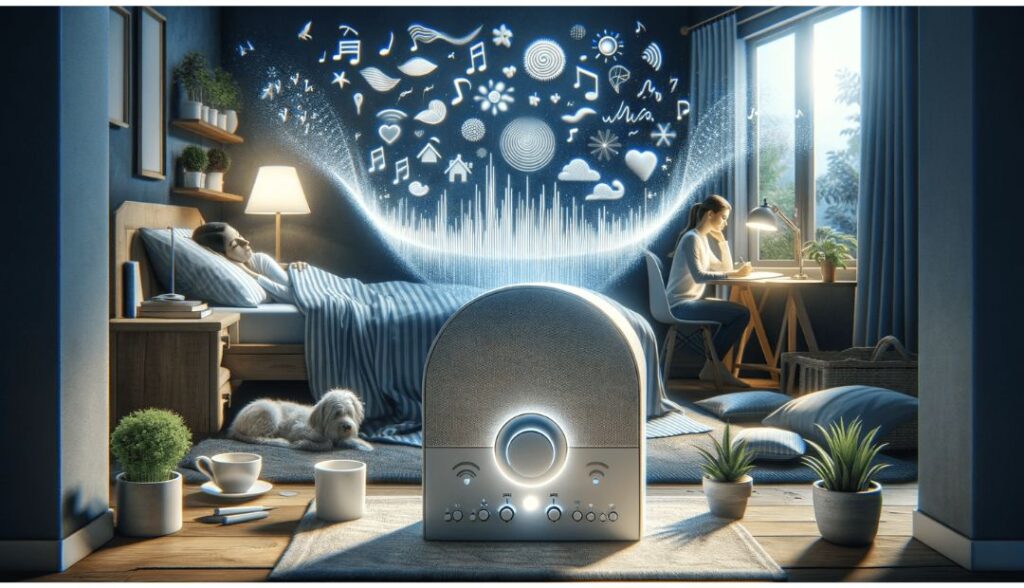White noise refers to a consistent sound that combines all audible frequencies, each at an equal intensity. This acoustic phenomenon differs from other types of noise, such as pink noise or brown noise, which emphasize certain frequencies over others. White noise, therefore, provides a uniform auditory experience, producing a ‘masking’ effect that can help to obscure disruptive sounds.
The term “white noise” is derived from the analogy to white light, which consists of all visible wavelengths in the light spectrum. In the same way, white noise contains all audible frequencies at equal power. Common sources of white noise include natural elements like waterfalls, wind, and rain, as well as electronic devices such as fans, air conditioners, and specialized white noise machines.
The significance of white noise extends across several fields. In acoustics, white noise is employed to test and calibrate audio equipment because of its spectral uniformity. In electronics, it is used in various applications, including signal processing and random number generation. In daily life, white noise’s most recognized use is for sleep and concentration aids. Its ability to mask background noise makes it an effective tool for creating a serene environment, whether in a bustling office or a noisy neighborhood.
Understanding the characteristics and applications of white noise is crucial in grasping its utility in different contexts. Whether for scientific purposes or personal well-being, the consistent and harmonious qualities of white noise make it a versatile and valuable auditory phenomenon.
The Science Behind White Noise

White noise is a complex auditory phenomenon deeply rooted in both mathematics and physics. Fundamentally, white noise is defined by its unique frequency spectrum, which spans across the entire range of human hearing—typically from 20 Hz to 20,000 Hz. Unlike music or other types of sound, white noise maintains an equal intensity across all these frequencies. This constancy creates a uniform sound that can blend other auditory inputs into a steady, consistent background.
The generation of white noise involves a continuous and random signal that combines every possible frequency in the audible range. Technically, this randomness means that at any given moment, the sound’s amplitude—the height of the sound wave—can take any value within a certain range. This generates the characteristic “hiss” or “static” sound commonly associated with white noise machines and various electronic devices.
Mathematically, white noise is often represented as a stochastic, or random, process. Engineers and scientists utilize Fourier transformation to analyze and generate white noise. When visualized on a frequency spectrum, white noise appears as a flat line. This graphical representation indicates that all frequencies contribute equally to the overall noise, which is essential for its masking effects. The absence of peaks and troughs within this spectrum allows white noise to effectively mask other sounds, making it a popular tool for enhancing concentration or improving sleep quality.
On the physical side, the perception of white noise in humans is influenced by the inner ear’s sensory cells. These cells, known as hair cells, respond to different frequency components of the white noise and convert these sound waves into electrical signals. The brain then interprets these signals, often perceiving white noise as a consistent background hum. The uniform distribution of sound energy across frequencies ensures that no particular tone stands out, reinforcing its capability to minimize or mask environmental noises. This unique attribute is why white noise has become a staple in both commercial and therapeutic noise reduction solutions.
Types of White Noise
White noise encompasses a wide range of sounds, all characterized by their ability to mask other noises by producing a consistent background sound. These can be broadly categorized into natural and artificial sources, each with its unique properties and applications.
Natural white noise originates from environmental sounds that have been with humankind for centuries. Some of the most common examples include the sound of rain, ocean waves, and wind rustling through trees. The constant patter of raindrops can create a soothing, calming atmosphere, often used in relaxation settings or for aiding sleep. Similarly, the rhythmic crash of ocean waves provides a serene background, frequently utilized in meditation or to foster concentration in work environments. These natural sounds have a broad frequency range, making them effective at drowning out disruptive noise.
On the other hand, artificial white noise is generated through man-made means, often using electronic devices or digital platforms. Classic examples include the static sound from a television when it’s not tuned to a channel, and the hum of air conditioning units or fans. These sources provide a steady, unvarying noise that can mask sudden disruptive sounds. Digital platforms can also generate white noise tailor-made for specific purposes, such as easing sleep disorders, enhancing focus, or relaxing stress. These digitally generated sources often come in the form of apps or specialized devices designed to play continuous white noise.
Each type of white noise, whether natural or artificial, has its own unique applications depending on the desired outcome. In therapeutic settings, natural sources are often preferred for their organic and calming properties. Conversely, artificial white noise is frequently employed in office environments or urban areas to block out intermittent noises like traffic or conversations. Understanding the various forms and applications of white noise is paramount for effectively utilizing this auditory phenomenon to enhance daily living and mental wellness.
Applications of White Noise
White noise has myriad applications across diverse fields, enhancing both personal and professional environments. A prominent use is in the realm of sleep improvement. Scientific studies have demonstrated that white noise can significantly benefit individuals with insomnia or sleep disturbances. By generating a consistent, soothing background sound, white noise helps mask disruptive noises, facilitating a more restful sleep environment. This efficacy is supported by research published in the journal Sleep Medicine, where patients exposed to white noise experienced notable improvements in sleep quality and duration.
Beyond its applications in sleep, white noise is also utilized extensively for relaxation purposes. Various wellness practices and therapeutic settings incorporate white noise to create calming atmospheres. For example, spas and meditation centers often employ white noise to drown out intrusive sounds, thereby aiding in achieving a state of tranquility and focus. This calming effect has also found application in stress reduction therapies, as indicated in a study by the Journal of Advanced Nursing, which reported decreased anxiety levels in patients when white noise was used during relaxation sessions.
White noise’s ability to enhance concentration is another highly valuable application, especially in work and study environments. In chaotic or noisy settings, maintaining focus can be challenging. White noise helps by masking background chatter and environmental sounds, leading to improved concentration and productivity. Educational institutions and corporate offices have incorporated white noise machines to create more conducive environments for learning and working. Anecdotal evidence and user testimonials frequently highlight enhanced focus and decreased distractions as key benefits.
In industries such as sound engineering and music production, white noise serves a technical role. It is utilized to test and calibrate audio equipment, ensuring high fidelity and proper functioning. White noise can also be employed to enhance certain audio effects and mixes, contributing to clearer and more balanced soundscapes. This application underscores the importance of white noise in achieving precision and quality in auditory projects.
Overall, the versatility of white noise has been substantiated by empirical research and real-world examples, highlighting its significance in improving sleep, fostering relaxation, enhancing concentration, and refining sound engineering practices.
Benefits and Drawbacks of White Noise

White noise has gained popularity for its variety of potential benefits. One of the most acclaimed advantages is its ability to improve sleep quality. By providing a consistent auditory backdrop, white noise can mask disruptive environmental sounds, such as traffic or noisy neighbors, which can help individuals fall asleep faster and enjoy more restful sleep. This is especially beneficial for people with insomnia or those living in urban environments.
Improving focus and concentration is another significant benefit of white noise. In environments filled with unpredictable sounds, such as offices or schools, white noise can create a consistent auditory environment that minimizes distractions. As a result, individuals can achieve a higher level of focus, leading to enhanced productivity and performance in tasks that require sustained attention.
Furthermore, white noise has been cited as a tool for stress reduction. The consistent sound can act as a calming agent, helping to soothe the mind and alleviate anxiety. This is particularly useful for individuals who find themselves overwhelmed by the cacophony of daily life. The rhythmic nature of white noise provides a sense of stability and can induce a meditative state, promoting overall mental well-being.
However, white noise is not without its drawbacks. For some individuals, it can be ineffective or even irritating. Sensitivity to sound and personal preferences play a significant role in its efficacy. Additionally, an over-reliance on white noise can develop, leading to difficulties sleeping or concentrating without it. This dependency can be problematic if access to white noise is suddenly removed or if individuals struggle to find the right type of sound for their needs.
There are also health concerns to consider. Prolonged exposure to high volumes of white noise can potentially lead to hearing issues. It is crucial to maintain sound levels at a safe volume and to be mindful of one’s hearing health. Moreover, individuals with specific auditory-related health conditions should consult with a healthcare professional before incorporating white noise into their routine.
Overall, white noise offers several advantages for sleep, focus, and stress management, but its effectiveness varies from person to person, and care should be taken to avoid over-dependence or potential health risks.
How White Noise Machines Work
White noise machines operate by generating a consistent sound that encompasses a wide range of frequencies, effectively masking disruptive noises from the environment. At the core of these devices lies a mechanism typically based on either digital or analog technology. Digital white noise machines employ sound chips and software algorithms to produce synthetic sounds that mimic natural noise patterns, while analog machines use small fans or motors to create continuous physical sound waves.
The production of white noise involves the blending of all audible sound frequencies at equal intensity. This uniform distribution of sound energy across the frequency spectrum forms the characteristic “shh” sound, which helps cloak environmental noises that might disturb sleep or concentration. White noise machines often include modulating controls to adjust the intensity and range of frequencies being emitted, allowing users to customize the device to their specific needs.
When selecting a white noise machine, there are several critical features to consider. Volume control is essential to ensure the sound level can be adjusted to suit different environments and personal preferences. Sound quality is another vital factor; a high-quality machine will produce clear, consistent noise without listening fatigue or unwanted artifacts. Portability is also significant, especially for those who travel frequently or need a compact solution for various rooms in their home or office.
Additionally, many white noise machines come with extra functionalities that enhance their usability. For instance, some models offer a range of sound options beyond white noise, such as nature sounds or soothing melodies, providing greater flexibility. Timers and automatic shut-off features can also be very convenient, conserving energy and preventing the machine from running unnecessarily when not needed. Advanced models may include connectivity options like Bluetooth, allowing users to control the device via smartphone apps for added convenience.
In conclusion, understanding the technical underpinnings and available features of white noise machines can significantly aid in selecting the right device to foster a more restful or focused environment.
Setting Up Your Environment with White Noise
Incorporating white noise into your daily routine can be an effective way to enhance various aspects of your environment, whether it’s for sleep, work, study, or relaxation. The first step in setting up your environment is to select a reliable source of white noise. This could be anything from a dedicated white noise machine to a smartphone app or even a fan. Each source has its own pros and cons, so it’s important to choose the one that best suits your specific needs.
When it comes to white noise machines, they offer a range of sound options and are designed to run continuously without disruption. To optimize these for sleep, place the machine a few feet away from your bed. Ensure the volume is high enough to mask disruptive noises but not so loud that it becomes a disturbance itself. Many machines also come with different settings for varying types of background noise, such as ocean waves or rain, which can be used to enhance relaxation and comfort.
White noise apps are convenient, especially for those who travel frequently. Many apps also offer additional features such as timers and a variety of soundscapes. For studying or working, consider using headphones to help focus more closely on the white noise and drown out external distractions. Choose settings that provide a consistent, smooth sound without sudden interruptions that could break concentration.
For relaxation spaces, combining white noise with other calming elements can create a more serene atmosphere. Options such as dim lighting, aromatherapy, and comfortable seating can be paired with white noise to enhance the overall environment. Experiment with different sounds and volumes to find the ideal mix that helps you unwind and relax.
By strategically incorporating white noise into your daily settings, you can create a more controlled environment that promotes better sleep, increased focus, and a higher level of relaxation. With a bit of experimentation and adjustment, white noise can be a versatile and effective tool for improving your quality of life.
Frequently Asked Questions About White Noise
Understanding white noise can often bring up numerous questions, particularly regarding its distinctions from other types of noise, its safety, and troubleshooting concerns. Here, we address some of the most frequently asked questions.
What is the Difference Between White Noise and Other Noise Colors (Pink, Brown)?
White noise contains equal power across all frequencies, offering a consistent sound. Pink noise, on the other hand, has more power in the lower frequencies, which makes it sound deeper. Brown noise, also known as Brownian noise, goes a step further, with an even greater emphasis on low frequencies, creating a rumbling sound. These variations cater to individual preferences and purposes, such as easing sleep troubles or enhancing concentration.
Are There Any Long-Term Effects of Using White Noise?
Studies have shown that white noise can be an effective aid for sleep and concentration without adverse long-term effects. However, as with any auditory stimulus, prolonged exposure at high volumes can potentially lead to hearing damage. Therefore, it is essential to maintain a moderate volume level when using white noise devices for extended periods.
Is White Noise Safe for Children and Pets?
White noise is generally safe for children and pets when used appropriately. For infants, using white noise can help them fall asleep and stay asleep by masking household noises. To ensure safety, it’s crucial to keep the volume at a safe level (usually not exceeding 50 decibels) and place the noise source away from the crib. Pets typically respond well to white noise as it can calm them during stressful situations, such as thunderstorms or fireworks.
How Can I Troubleshoot Common Issues with White Noise Devices?
Common issues with white noise devices often include poor sound quality, device malfunction, or difficulty finding the right setting. If the sound quality is compromised, check for any obstructions near the device’s speaker and ensure it is on a stable surface. For device malfunctions, consult the user manual for troubleshooting steps or reach out to customer support. When selecting the right setting, experiment with different noise colors or volume levels until you find the most effective for your needs.
By addressing these key concerns, users can better understand and effectively use white noise to improve their quality of life.



